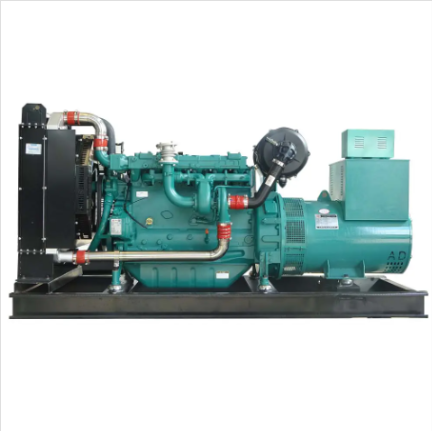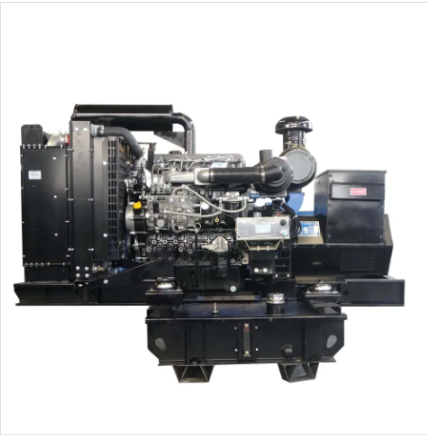Ძირითადი ტიპები Ელექტრო გენერატორებს და მათ ძირითადი განსხვავებები
Პორტატიული გენერატორები: მობილურობა და დროებითი ელექტროენერგიის ამოხსნები
Პორტატიული გენერატორები დამზადდა ისე, რომ ისინი იოლად გადაადგილდნენ, რაც უზრუნველყოფს მათ გამოყენებას გარე საღამოებზე, კემპინგში ან როდესაც არაგონივ გათიშულია ელექტროენერგია მთავარი . მათ უმეტესობა მუშაობს ბენზინზე და გამომუშავებს სადაც 1,000-დან 10,000 ვატამდე ელექტროენერგიას. ასეთი სიმძლავრე საკმარისია სახლის გასაშრობად, მაგალითად სინათლის, მაცივრის ან საჭირო დროს სამუშაო ხელსაწყოების მოსაწყენად. ბევრი ახალგაზრდა მოდელი უკვე შეიცავს უსაფრთხოების ზომებს, როგორიცაა ავტომატური გამორთვა, თუ ზეთის დონე ძალიან დაბალია, რაც აიძულებს გენერატორს დაზიანების თავიდან ასაცილებლად. მაგრამ აქ არის ერთი მნიშვნელოვანი რამ, რაც ადამიანებმა უნდა გახსოვდეთ პორტატიული გენერატორების შესახებ. ელექტროუსაფრთხოების საფუძვლის მიხედვით (ESFI), ყოველწლიურად ადამიანები იმართლებიან, რადგან არ იყენებენ ამ მანქანებს სწორად. ამიტომ ყოველთვის წაიკითხეთ ინსტრუქცია პირველად, სანამ საელოდაო მოწყობილობის ჩართვას შეეცდებით.
Რეზერვული გენერატორები: ავტომატური დამატებითი დახმარება კრიტიკული სისტემებისთვის
Სარეზერვო გენერატორები მოქმედებენ როგორც ავტომატური საწვდომი ენერგიის წყაროები, რომლებიც იწყებენ მუშაობას გადართვის შემთხვევაში და უზრუნველყოფენ ელექტროენერგიის უწყვეტ მიწოდებას ხელისუხლის ჩარევის გარეშე. უმეტესი მოდელი მუშაობს ბუნებრივ ან პროპან ბუტან აირზე, რაც მათ გამოყენებას უფრო მარტივს ხდის და გარემოსთვის უფრო სასიკეთოდ აქცევს ძალიან ძველი დიზელის ვერსიების შედარებით, რომლებსაც ადამიანები ადრე იყენებდნენ. ერთის დაყენება და მისი კარგი მდგომარეობის შენარჩუნება მაინც მოითხოვს კვალიფიციური ტექნიკოსების პროფესიონალურ დახმარებას. სწორი დაყენებაზე დახარჯული დრო და ფული მოგებით გამოდგება სანდო ელექტრომომარაგების თვალსაზრისით, რაც განსაკუთრებით მნიშვნელოვანია საცხოვრებელი სახლებისთვის, პატარა ბიზნესისთვის და ადგილებისთვის, სადაც ელექტროენერგიის გათიშვა საერთოდ დაუშვებელია. აშშ-ის მომხმარებელთა პროდუქტების უსაფრთხოების კომისიამ აღნიშნა, რომ სახლებში, სადაც გამოიყენება სარეზერვო გენერატორები, სერვისის შეწყვეტების შემთხვევები გაცილებით ნაკლებია, რაც სამედიცინო დაწესებულებებში და სხვა სამაშველო სამსახურებში განსაკუთრებით მნიშვნელოვანია, სადაც უმოკლესი გამორთვა საფრთხის შემთხვევაშიც კი სერიოზულ პრობლემებს იწვევს.
Ინვერტერული გენერატორები: სუფთა ენერგია შეძლების სენსიტიური ელექტრონიკისთვის
Ინვერტორული გენერატორები წარმოქმნიან უფრო სუფთა ენერგიას დაბალი ხარჯით, ამიტომ ისინი კარგად მუშაობენ მოწყობილობებთან, რომლებიც არ არის მგრძნობიარე ძაბვის შეტევების მიმართ, როგორიცაა ნოუთბუქები და ტელეფონები. ჩვეულებრივი გენერატორებთან შედარებით, ასეთი მოდელები მუშაობის დროს უფრო ნაკლებად ხმაურიანია, ასევე მრავალი მოდელის შეუძლია საწვავის ტიპის გადართვა მისი ხელმისაწვდომობიდან გამომდინარე. ვისაუბროთ მანქანებზე, რომლებიც საკმარისად პატარაა ჩასატევად ჩანთაში, მაგრამ საკმარისად ძლიერია გარე სივრცეში გამოსაყენებლად, რამაც მას საუკეთესო ადგილზე დააყენა კემპინგის მოყვარულებისა და სპორტული ღონისძიებების მონაწილეების შორის. ბაზრის კვლევები მიუთითებს, რომ ეს ტენდენცია შენარჩუნდება. ტექნავიოს ბოლო მონაცემების მიხედვით, გაყიდვები უნდა გაგრძელდეს წელზე დაახლოებით 6% სიჩქარით 2025 წლამდე, რაც ასახავს მოთხოვნის მაღალ დონეს ამ მრავალფუნქციური პატარა ენერგოსადგურების მიმართ.
Ინდუსტრიული გენერატორები: მაღალი სიმძლავრის ელექტროენერგია მოთხოვნადი გამოყენებისთვის
Ინდუსტრიული გენერატორები მძლავრ ელექტროენერგიას უზრუნველყოფს სამშენებლო მოედნებზე, მაღაზიებში და ქარხნებში სამუშაო პროცესების მსვლელობისას. მათ უმეტესობა დიზელზე მუშაობს, რადგან ეს მათ სჭირდებათ მაშინ, როდესაც სიტუაცია ძალიან დამახასიათებელი ხდება. ამ მანქანების განსაკუთრებული მახასიათებელი ის არის, რომ ისინი მუშაობენ წელზე მეტი ხანის განმავლობაში დამახასიათებელი მუშაობის შემდეგაც. ლითონის ნაწილები საკმარისად გრძელია, რომ გაძლონ ნებისმიერი დატვირთვა, რომელიც ყოველდღიურ ექსპლუატაციაში შეიძლება წარმოიშვას. ბოლო ბაზრის ანალიზის მიხედვით MarketsandMarkets-ის მიერ, ინდუსტრიული გენერატორების მოთხოვნა მიუთითებს რომ 2025 წლის შუა რიცხვით მიაღწევს 25,7 მილიარდ დოლარს. ასეთი ზრდა აჩვენებს რამდენად მნიშვნელოვანია საიმედო სარეზერვო ელექტრომომარაგება ბიზნესისთვის, რომელიც ვერ იტანს დროის დაკარგვას ნებისმიერი გარემოების გამო.
Სოლარული გენერატორები: ეკოლოგიური Off-Grid ორიენტირებული ენერგიის სისტემები
Მზის გენერატორები ძალიან გამართული ალტერნატივაა ძველი გაზის გენერატორების შედარებით, ვინაიდან ისინი ელექტროენერგიას მზის სინათლიდან იღებენ. ადამიანები, რომლებიც მარტოხელა ცხოვრობენ, ამ სისტემებს საკმაოდ სასარგებლოდ იყენებენ კემპინგში გასვლისას რიცხვით დასასრულზე, სატრანსპორტო საშუალებებში გასვლისას ან იმ იზოლირებულ ქოშებში დასარესტავად, სადაც ჩვეულებრივი ელექტრომომარაგება ხელმისაწვდომი არ არის. დღევანდელი უმეტესი მოწყობილობები აკუმულატორებით არის დამაგრებული, რაც საშუალებას გვაძლევს დავაგროვოთ დამატებითი ენერგია დღის განმავლობაში და შემდეგ საჭიროების შემთხვევაში გამოვიყენოთ, რაც ყველაფერს უფრო მარტივს ხდის. ბოლო მონაცემების მიხედვით, რომლებიც მზის ენერგეტიკის ინდუსტრიის ასოციაციიდან მოვიდა, ამერიკაში მზის ენერგიის წარმოება ბოლო ხუთ წელში გაიზარდა სამჯერ, რაც აჩვენებს ამ ტექნოლოგიის სისწრაფის გავრცელებას სუფთა ენერგიის მომხმარებლების შორის.
Საწვავის ტიპები და მათი გავლენა გენერატორის მუშაობაზე
Დიზელის გენერატორები: დარბაზი მძიმე გამოყენებაში
Დიზელის გენერატორებმა მყარი რეპუტაცია შეიმუშავეს, ვინაიდან ისინი უფრო ხანგრძლივად გრძელდებიან და უკეთ მუშაობენ რთულ პირობებში. გაგრძელებული დროის განმავლობაში მუშაობისას ისინი ნამდვილად ნაკლებ საწვავს ხარჯავენ გაზის ანალოგებთან შედარებით, რაც მათ ხდის უფრო ხელსახებ ხარჯებს დროის განმავლობაში. დიზელის საწვავს უფრო მეტი ძალა აქვს გალონზე, ასე რომ ეს მანქანები უფრო მუშაობენ მაშინ, როდესაც სხვა ვარიანტები შეიძლება მოხდეს მათი მუშაობის შეწყვეტა. მშენებლობის ადგილები, მადნების მოპოვების სამუშაოები და ადგილები სადაც ენერგიის მიწოდება რთულია, მძიმედ დამოკიდებულია დიზელის გენერატორებზე, ვინაიდან ისინი არ შეწყვეტენ მუშაობას თუნდაც მუდმივი მუშაობის რამდენიმე თვის განმავლობაში. უმეტესობა ინდუსტრიული საწარმოების არიდებენ დიზელის მოდელებს უბრალოდ იმიტომ, რომ გამოცდილებიდან იციან, რომ ეს მოწყობილობები მუშაობენ მაშინ, როდესაც სხვა ყველაფერი შეიძლება მათ შეაჩეროს მნიშვნელოვანი მომენტების დროს.
Ბუნებრივი აირის გენერატორები: დაბალ-გამოსვლის კომერციული ამოხსნები
Ბევრი ადამიანი ბუნებრივი გაზის გენერატორებს ასახელებს, როგორც ნაკლებად მავნე ავტომობილებს, რომლებიც სუფთად უფრო მეტად იწვიან ტრადიციული დიზელის ან ბენზინის ალტერნატივებთან შედარებით, რაც მათ საერთო გარემოს უფრო მეტად უსარგებლოს ხდის. საწარმოები მიდრეკილნი არიან მიერთონ ასეთი მოწყობილობები, ძირითადად იმიტომ, რომ ისინი უზრუნველყოფენ სტაბილურ ელექტროენერგიას გარემოს დაცვის სტანდარტების შეუხებლობით. მათ განსაკუთრებით მისაღებს ხდის შესაძლებლობა ქალაქის ბუნებრივი გაზის სადენ ხაზთან დაკავშირებისა, რაც ნიშნავს, რომ ყოველთვის მოწოდებულია საწვავი სამუშაო პროცესებისთვის. კომპანიებისთვის, რომლებიც ცდილობენ ნახშირბადის სახით გამოყოფილი ნარჩენების შემცირებას, ასეთი სანდოობის ფაქტორი დაბალი გამონაბოლქვებთან ერთად ხდის ბუნებრივი გაზის გენერატორებს გამოჩენილ ალტერნატივად სხვა საავარიო ენერგომომწოდებელი ამონახსნების შორის დღევანდელ ბაზარზე.
Ჰიბრიდული სისტემები: ეფექტიურობის და მწვრთნელობის განსაზღვრა
Ჰიბრიდული გენერატორები აერთიანებს ჩვეულებრივ საწვავს მზის პანელების ან ქარის ტურბინების მსგავს მწვანე ალტერნატივებთან, რაც გამოხატავს ნამდვილ პრინციპულობას გამწვანების მიმართულებით. ასეთი სისტემების უმჯობესობას უზრუნველყოფს საწვავის ეფექტიანად გამოყენება მავნე გამონაბოლქვების შემცირებით, რაც მიმზღვარებს გარემოზე დამატებით მომწიფებულ ადამიანებს. კიდევ ერთი დიდი დამატებითი უპირატესობა არის მათი გატარებადობა, ისინი შეძლებენ გაუმკლავდეს დღის განმავლობაში ელექტროენერგიის მოთხოვნის ცვლილებებს, ამიტომ ისინი ხვდებიან პოპულარობას პატარა ბიზნესიდან დიდ მანქანათმშენებლურ საწარმოებამდე სფეროებში. როგორც კი კომპანიები უმაღლეს ხარისხად უმაგრებენ ამ კომბინირებულ ენერგეტიკულ ამონახსნებს, ვხედავთ მთელი ენერგეტიკის სფეროს გაწმენდას მიმართულებით, გარეშე იმისა რომ დავუშვათ გენერატორების ეფექტიანობის დაკარგვა.
Პროპანის გენერატორები: ვერსატილობა დამალული მოქმედებებისთვის
Პროპანის გენერატორები საკმაოდ მრავალფუნქციურია და მუშაობს როგორც სანდო ელექტროენერგიის წყარო, როდესაც ადამიანებს სჭირდებათ ელექტროენერგია დაშორებულ ადგილებში, ბუნებრივი ან ტექნოგენური კატასტროფების დროს ან კემპინგისას და მოგზაურობისას. საწვავი იწვის ნაკლებად დამაბინძურებლად, ვიდრე ბევრი ალტერნატივა, ამიტომ ის ნაკლებ აბინძურებს გარემოს და აკმაყოფილებს უმეტეს გარემოსდაცვით სტანდარტებს. ერთ-ერთი დიდი პლიუსი არის ის, რომ პროპანი არ იშლება, როგორც გაზოლინი დროის განმავლობაში, ამიტომ ადამიანები, რომლებიც ამზადებიან არასასიამოვნო შემთხვევებისთვის, ხშირად ისესხებენ პროპანზე მომუშავე გენერატორებს. ასეთი მოწყობილობები შეიძლება გამოყენებულ იქნას სხვადასხვა შემთხვევაში, მაგალითად მშენებლობის ადგილებში ან სახლებში საუკეთესო ელექტრომომარაგებისთვის, რაც აჩვენებს მათ მნიშვნელობას ელექტროენერგიის მიმწოდებაში იმ ადგილებში, სადაც არ არსებობს ქსელური მომარაგება.
Გამოყენება სექტორებში: რეზიდენტური, კომერციული და ინდუსტრიული საჭიროები
Რეზიდენტური გამოყენება: განათლების დამატებითი დახმარება და გარემოში ძალა
Როდესაც სინათლე უცებ გაქრება, საცხოვრებელი სახლების გენერატორები ნამდვილად იმარჯვებენ სიცოცხლის შენარჩუნებაში, რათა სახლები დარჩეს კომფორტული. ისინი იწყებენ მუშაობას გასატარებლად სიმძლავრის იმ რამეებზე, რაც ჩვენ ნამდვილად გვჭირდება გასატარებისას, როგორიცაა სითბო, როდესაც გარეთ ცივია, ჰაერის გამაგრილებელი ცხელ დღეებში და საკვების შენახვა, რომ არაფერი გაფუჭდეს. ამის გარდა ავარიული სიტუაციების შესახებ, ეს საშუალებები ასევე გამოსადეგია გარე სივრცეების სხვადასხვა საშუალებებისთვისაც. ბაღებში შესაძლოა მათი მოწყობილობების გამოყენება, ქალაქის სასტუმროებში დარჩენილი ადამიანები ხოლმე დარჩებიან დაკავშირებული, ხოლო ადამიანები, რომლებიც ადამიანებს ატარებენ და არ უნდა იშლებოდეს ელექტროენერგია შესხვების შუა დღეს. უმეტესობა ადამიანისთვის ან ის საგანია, რომელიც ისინი სასურველია მოძრაობა ან დამაგრება რომელიმე ადგილში მუდმივად. პორტატიული მოწყობილობები კარგად მუშაობს იშვიათად გამოყენებისთვის, მაგრამ შესაძლოა არ იყოს საკმარისი, თუ ვინმე ცხოვრობს ადგილას, სადაც ხშირად ხდება გამორთვები. მომზადებული მოდელები უფრო მაღალ ფასს ითხოვს დაწყებისთვის, მაგრამ დროის განმავლობაში ისინი გამარტივდებიან, ვინაიდან ისინი თვითონ იწყებენ მუშაობას ნებისმიერი გამორთვის დროს ადამიანის მიერ ხელით რაიმე დაკავშირების გარეშე.
Კომერციული გამოყენება: მონაცემთა ცენტრები და რეტეილის ინფრასტრუქტურა
Დღესდღეობით საყიდლო მაღაზიებისა და მონაცემთა ცენტრების მუშაობისთვის დამოუკიდებელი ელექტროენერგიის მიწოდება არის არასავალდებულო პირობა. როდესაც გამორთულია ელექტროსინათლები, ავარიული გენერატორები იწყებენ მუშაობას სერვერების გასაგრძელებლად, რათა კომპანიებმა არ დაკარგონ მომხმარებელთა ტრანზაქციები ან ფასდაუკლებელი ინფორმაცია გაუთვალისწინებელი გამორთვების დროს. საინტერესოა, რომ გენერატორების მწარმოებლებმა დაიწყეს პროდუქტების მორგება სხვადასხვა სახის სავაჭრო დაწესებულებებისთვის. ბუტიკის მაღაზიას სჭირდება სრულიად განსხვავებული ამონახსნი, ვიდრე ჰოსპიტალს სჭირდება. ეს მორგება ნიშნავს, რომ ბიზნესის სუბიექტებს ზუსტად მიეცემათ ის, რაც საჭიროა ქსელის დამაგრებისას მუშაობის გასაგრძელებლად, რაც საბოლოოდ იცავს შემოსავლის წყაროებს და შეინარჩუნებს მომხმარებელთა ნდობას არის ავარიულ მდგომარეობებში.
Ინდუსტრიული მოთხოვნები: მინინგი, კონსტრუქცია და მანქანები
Მრეწველობითი გენერატორები საუკეთესოდ აგებულია მრეწველობის სხვადასხვა სახეობებში დიდი დატვირთვის მოთხოვნების დასაკმაყოფილებლად, მათ შორის მაინინგის ადგილებში, მშენებლობის ზონებში და ქარხნებში სადაც ისინი გამძლე ადგილებში მუშაობენ. ისინი დამზადებულია იმ ყველაფრის გასაღებად, რასაც ბუნება უბრძვის მათ და მუშაობის მუდმივი დახმარებით ისინი განაგრძობენ მუშაობას, როდესაც ყველაფერი დანარჩენი უკვე უმოქმედოა. რა განსაკუთრებულს ხდის ამ მანქანებს? შესაძლებლობები, როგორიცაა დატვირთვის მონიტორინგის სისტემები და გონივრული შენარჩუნების შეტყობინებები დახმარებას ახდენს კომპანიებს იმ შეწყვეტების თავიდან ასაცილებლად, რომლებიც ფულსა და დროს მოკლებს. უმეტესობა ბიზნესის წარმომადგენელთა ასეთი საიმედოობა საკმაოდ მნიშვნელოვანად მიიჩნევს გრძელვადიანი წარმოების პროცესში, სადაც უმცირესი შეფერხებაც კი შესაძლოა გამოწვეული იქნას მართვის სირთულეებით.
Ტელეკომუნიკაციები და ჯანდაცვა: მისიონეროვანი ძალის გამოსავალი
Ძალა რომელიც არ გამოირთვება მნიშვნელოვან როლს თამაშობს ტელეკომუნიკაციების კომპანიებისა და საავადმყოფოებისთვის, სადაც ხალხს სჭირდება მუდმივი კავშირი და პაციენტები დამოკიდებული არიან სიცოცხლის შენარჩუნების აღჭურვილობაზე, რომელიც მუდმივად უნდა იმუშაოს. ამიტომ გენერატორები ასეთ ადგილებში იმდენად მნიშვნელოვანია, ისინი მოქმედებენ როგორც უსაფრთხოების ბადე ძირითადი დენის გასვლის შემთხვევაში. უმეტეს დაწესებულებებში არსებობს მკაცრი წესები ადგილობრივი ხელისუფლებისა და საინდუსტრიო სტანდარტების მიხედვით ავარიული ელექტრომომარაგების შესახებ. ფიქრობთ თუ რა ხდება საავადმყოფოს გადაულახველ დროს შეჩერდება უკვე სრული ბნელში ან როდესაც უკვე უკვე მობილური ტელეკომუნიკაციების აშშ-ში გაუმჯობესებული გენერატორები უზრუნველყოფენ მუშაობის განახლებას მიუხედავად იმისა, თუ რა ხდება სხვაგან, ამიტომ უმეტესობა სერიოზული ბიზნესის მიუხედავად ხარჯებისა ინვესტირებს მაღალხარისხიან საშუალებებში.
Ტექნოლოგიური განვითარებები ახალ გენერატორულ სისტემებში
Განათებული მონიტორინგი და პრედიქტიული მართვის ინსტრუმენტები
Გენერატორის მუშაობის მონიტორინგის ტექნოლოგიამ შეცვალა თამაშის წესები. ახლა ხალხს შეუძლია სისტემების შემოწმება ნებისმიერი ადგილიდან და მიიღოს მაქსიმალურად ეფექტუანი მუშაობა. ასეთი სისტემები საშუალებას აძლევს ოპერატორებს ადრე შეამჩნიან პრობლემები და შესაბამისად შეცვალონ ენერგიის წარმოება. პროგნოზირებითი შენარჩუნების ფუნქცია ასევე გამოირჩევა. ის ანალიზის უშვებს გენერატორების გამოყენების სიხშირეს, მათ მუშაობას მაღალი დატვირთვის პირობებში და სხვა მონაცემებს. როდესაც რამე გადახრა ხდება, სისტემა გამოუშვის შეტყობინებას, რათა პრობლემა გადაწყვიტონ უფრო სერიოზული გამართვის არ მოხდეს. ასეთი სახის მომსახურება ამცირებს გაუთვალისწინებელ შეჩერებებს და გაზრდის გენერატორის სიცოცხლის ხანგრძლივობას. ეს კი ნიშნავს იმას, რომ უფრო ნაკლები არასასურველი ინციდენტი მოხდება დამატებითი დატვირთვის დროს ან კრიტიკულ სამსახურში. სახლის მომხმარებლებისა და ბიზნესის წარმომადგენლებისთვის სარგებელი ნათელია, თუმცა კომერციული ოპერაციების შემთხვევაში სარგებელი უფრო მეტია, რადგან მათ მუდმივ და უწყვეტ ენერგიის მიწოდებაზე აქვთ დამოკიდებულება.
Ინტეგრაცია განათლების მიკროქსელებთან
Დღევანდელი გენერატორები შესაძლოა თანამშრომლობა მიაწოდონ აღდგენითი ენერგიის წყაროებთან ერთად, რათა ააშენონ ეფექტური მიკროსისტემები, რომლებიც უმჯობესად იყენებენ ხელმისაწვდომ ენერგიას. როდესაც ეს სისტემები სწორად ინტეგრირდებიან, ისინი ეხმარებიან ენერგომოხმარების მართვაში, ვინაიდან ისინი შესაძლოა მოიპოვონ ენერგია მზის პანელებიდან, ქარის ტურბინებიდან ან სხვა გრინ წყაროებიდან, როდესაც ხელმისაწვდომია. გენერატორები ჩაერთვებიან როგორც საშუალო დამაგრების საშუალება მაღალი მოთხოვნის დროს ან როდესაც აღდგენითი წყაროები არ ქმნიან საკმარის ელექტროენერგიას. ასეთი მიკროსისტემების შექმნა უზრუნველყოფს საზოგადოებებს ძველი ტიპის საწვავზე დამოკიდებულების შემცირებას, ხოლო ენერგიის განაწილებას უზრუნველყოფს იმ ადგილებში, სადაც ყველაზე მეტად სჭირდება. აღდგენითი ენერგიის ქალაქებისთვის მომავლის განსაზღვრისა და უფრო მტკიცე ენერგოსისტემების ასაშენად მნიშვნელოვანი ნაწილის გახდომის გამო, ამ გენერატორების მოდერნიზებული ვერსიები ასადაგებს სტაბილურობას ჩვენი ცვალებადი ელექტრო ლანდშაფტის განვითარებაში.

Шумის შემცირება და კომპაქტური მოდულარული დიზაინები
Მოწყობილობების ახალი ტენდენციები განსაკუთრებით აკეთრებს ხმაურის დონის შემცირებაზე, რაც მეზობლობებში და სხვა ადგილებში მნიშვნელოვან როლს თამაშობს, სადაც სიჩუმე არის აუცილებელი. ახალი ტექნოლოგიები ამ მანქანებს უფრო ხანგრძლივად ხდის, ვიდრე ადრე იყო, ამიტომ ისინი კარგად მუშაობენ ქალაქებშიც კი, სადაც აღჭურვილობის სიმტკიცის მკაცრი წესებია. ასევე ვხედავთ, რომ პატარა, მოდულური ერთეულები უფრო პოპულარული ხდება, რადგან ისინი ნაკლებ ადგილს იკავებენ და მათი დაყენება უფრო იოლია, როდესაც ვინმეს სწრაფად სჭირდება გენერატორის დაყენება. დღეს გენერატორების მეტი კომპანია დიდ ყურადღებას აქცევს მათი პროდუქტების მარტივად გამოყენებაზე, მარტივი მართვის სისტემებიდან დაწყებული და ინდიკატორებით დამთავრებული, რომლებიც აჩვენებენ, როდის უნდა შეივსოს საწვავი. ეს გაუმჯობესებები გენერატორებს ხელმისაწვდომს ხდის არა მხოლოდ ექსპერტებისთვის, არამედ ნებისმიერისთვის, ვისაც სჭირდება სანდო ენერგია უსარგებლო ხასიათის გარეშე, რაც ჩვეულებრივ უკავშირდება ტრადიციულ მოდელებს.
AI-გარემოში მუშაობის სისტემები
Ხელოვნური ინტელექტის მიერ მოძრავი ტვირთის მართვის სისტემები აღნიშნავს მნიშვნელოვან გადახრას ამ დღეს ენერგიის წარმოების მართვის მიმართულებით. ეს სისტემები დინამიურად აკეთებს გამომუშავებული ენერგიის მოცულობას იმის მიხედვით, თუ რა არის საჭირო ამ ეტაპზე, რაც ხელს უწყობს გენერატორების უკეთესად მუშაობას დამატებითი საწვავის გახარჯვის გარეშე. იმ ინდუსტრიებისთვის, სადაც ელექტროენერგიის მოთხოვნა დღის განმავლობაში იცვლება, ასეთი სმარტ კონტროლი ყველაფერს განსხვავებულად აკეთებს. მაგალითად, მანქანაშენების ქარხნების შემთხვევაში, სხვადასხვა რაოდენობის ელექტროენერგია სჭირდებათ წარმოების გრაფიკის დამოკიდებულებით. როდესაც სმარტ ალგორითმებთან ინტეგრირდება, ასეთი ხელოვნური ინტელექტის სისტემები გენერატორებს უფრო სწრაფად უმუშავებს პირობების შეცვლაზე და უცნაურ მდგომარეობებში გადაადაპტირებს. შედეგად კი ხდება ექსპლუატაციის ხარჯების შემცირება და ნაკლები ნარჩენების გამოყოფა გარკვეული დროის განმავლობაში. მიუხედავად იმისა, რომ ეს სფერო კიდევ ახალგაზრდაა, ენერგიის მართვის ხელოვნური ინტელექტის ამონახსნები უკვე იმყოფება იმ გზაზე, სადაც კომპანიები განსაზღვრავენ ენერგიის გენერაციის ეფექტურობის ახალ გაგებას, მიუხედავად იმისა, თუ ზუსტად რამდენად დიდი გავლენა იქნება მათი მომავალი გავლენა.
Იდეალური გენერატორის არჩევა: მთავარი გადაწყვეტილების ფაქტორები
Საჭირო ხარისხის გამოთვლა: ვატები და მუშაობის დრო
Მოწყობილობის სიმძლავრის გაანგარიშება უზრუნველყოფს იმას, რომ ამაღლდეს გენერატორის მაჩვენებლების სიზუსტე და შესაბამისად შეირჩეს საჭირო ზომის მოწყობილობა. პირველი ნაბიჯი არის იმ ვატების რაოდენობის დადგენა, რომლებსაც საჭიროებენ სასიცოცხლოდ მნიშვნულოვანი ხელსაწყოები და სისტემები მუშაობის დროს. ნუ დაგავიწყდებათ გათვალისწინება იმ მოწყობილობების მოხმარება, როგორიცაა მაგალითად მაცივრები ან სამედიცინო აპარატები, რომლებიც გრძელდება მუშაობას მაშინაც კი, როდესაც სხვები გაჩერდებიან. მნიშვნულოვანია გათვალისწინებული იქნას გამართული დროც კიდევ გადატვირთვის დროს, ამიტომ იმის განსაზღვრა, თუ რამდენად ხანგრძლივად უნდა გაგრძელდეს ელექტრომომარაგება უზრუნველყოფს სწორ დაგეგმვას. როდესაც ადამიანი დროს ათავისუფლებს და ყურადღებით ამუშავებს ამ მაჩვენებლებს, ის ირჩევს გენერატორს, რომელიც მის რეალურ ენერგომოხმარებას შეესაბამება, არა იმას, რაც გამოიგონება.
Სასურველი საწვავი წინააღმდეგი მუშაობის ხარჯებს
Საწვავის ტიპის შეფასება გენერატორის არჩევისას ყველაზე მნიშვნელოვან გადაწყვეტილებათა შორის მოიაზრება. არჩეული საწვავის წყაროს ხელმისაწვდომობა დიდ როლს თამაშობს, ასევე ფასების განსხვავება სხვადასხვა რეგიონში. ანგარიში იმაზე არ შემოიფარგლება, თუ რა შედის ბიუჯეტში თავდაპირველად. მუშაობის ხარჯებიც მნიშვნელოვანია, რადგან მომსახურების მოთხოვნები და საწვავის შენახვის შესაბამისი საშუალებები შეიძლება შეამციროს დროში დაგროვილი ეკონომია. ჭკვიანი მყიდველები ფასზე დამატებით ხედავენ და განიხილავენ სრულ საკუთრების ხარჯებს. ეს მიდგომა დახმარებას უწევს ფინანსური გამართულობის შენარჩუნებაში მოწყობილობის მთელი ვადის განმავლობაში და საჭიროების შემთხვევაში სანდო ენერგომომარაგების უზრუნველყოფაში.
Კლიმატური განსაზღვრება და შუქის ნორმები
Ამინდის პირობებს აქვთ მნიშვნელოვანი გავლენა გენერატორების მუშაობაზე, ამიტომ ტემპერატურის ექსტრემალური მნიშვნელობებისა და სიტევის მაჩვენებლის მაღალი დონის გათვალისწინება საჭიროა მოწყობილობების გამოყენების დაგეგმვისას. ხმაურის შეზღუდვები კიდევ ერთი ფაქტორია, რაც შეზღუდავს გენერატორების გამოყენებას, განსაკუთრებით სახლებისა და მიდამოების მახლობლად. ადგილობრივი წესები ხშირად განსაზღვრავს მოწყობილობების გამოყენების კონკრეტულ დროს ან დეციბელების ზღვარს. იმ მოდელების არჩევანი, რომლებიც შექმნილია ხმაურის დაბალ დონეზე მუშაობისთვის, სამართლებრივად და პრაქტიკულად გამართლებულია. ნაკლებად ხმაურიანი მოწყობილობები საშუალებას აძლევს ბიზნესს შეინარჩუნოს საჭირო ელექტრომომარაგება ხოლო ამასთან თავიდან აიცილოს მიდამოებში მყოფი მომსახურების საავად ხმაურის დაბრკოლებები მგზნობიარე საათებში.
Მარათონის განმავლობისთვის მართვის გრაფიკი
Მართვის გრაფიკის დაყენება ძალიან მნიშვნელოვანია გენერატორის განმავლობისთვის მართვისთვის. რეგულარული მართვა, რომელიც შემოწმებს მასლების შეცვლას, ფილტრების შეცვლას და მუშაობის შემოწმებას, არ დაარტყავს გაუმჯობეს ვადებს. ეს მართვის განახლება გამოიყენება მომხმარებლის ნადევს გენერატორის მართვის შესაბამისად და უზრუნველყოფს მუშაობის სამართლეს, რაც წვდომას გაძლევს განმავლობის განგრძელებას.
Ხშირად დასმული კითხვები
Რა არის ელექტრო გენერატორის ძირითადი ტიპები?
Არსებობს რამდენიმე ტიპი ელექტრო გენერატორი, მათ შორის პორტატიური, რეზერვული, ინვერტორი, ინდუსტრიული და სოლარის გენერატორები. თითოეული ტიპი მართალია განსხვავებულ ძალების საჭიროებებზე, მობილურობიდან წვიმის დაცვამდე.
Როგორ არჩეული გახდეს მართლივი გენერატორი ჩემი საჭიროებისთვის?
Განიხილეთ თქვენი ძალის საჭიროებები, საწვავის ხელმისაწვდომობა, მუშაობის ხარჯები, კლიმატი, შუქის ნორმები და მართვის გრაფიკები. ეს განახლება გეხმარებათ გენერატორის არჩევაში, რომელიც უკეთეს მanner-ით მოეწყობს თქვენს საკუთარ საჭიროებს.
Რა არის ინვერტორის გენერატორების სასიდიერო მიზეზები?
Ინვერტორის გენერატორები მოწოდებენ თავისუფალ ენერგიას მინიმალური ჰარმონიული დისტორციით, რაც ხდის მათ შესაბამის სანამდვილო ელექტრონიკასთვის. ისინი ასევე უფრო მომწიფეს და უფრო საწვავის ეფექტურია ტრადიციულ გენერატორების შედარენ.
Როგორ მუშაობს ჰიბრიდული გენერატორის სისტემები?
Ჰიბრიდული სისტემები ერთიანდება ტრადიციულ საწვავს და აღდგენით ენერგიის წყაროებს, რათა ოპტიმიზირდეს საწვავის გამოყენება, შეიმციროს გამონაბოლქვები და დაუკმაყოფილოს გარკვეული და განსხვავებული ენერგომოთხოვნა, რითაც გაიზარდება საერთო გამძლეობა შესრულების უკომპრომისობით.
Შინაარსის ცხრილი
-
Ძირითადი ტიპები Ელექტრო გენერატორებს და მათ ძირითადი განსხვავებები
- Პორტატიული გენერატორები: მობილურობა და დროებითი ელექტროენერგიის ამოხსნები
- Რეზერვული გენერატორები: ავტომატური დამატებითი დახმარება კრიტიკული სისტემებისთვის
- Ინვერტერული გენერატორები: სუფთა ენერგია შეძლების სენსიტიური ელექტრონიკისთვის
- Ინდუსტრიული გენერატორები: მაღალი სიმძლავრის ელექტროენერგია მოთხოვნადი გამოყენებისთვის
- Სოლარული გენერატორები: ეკოლოგიური Off-Grid ორიენტირებული ენერგიის სისტემები
- Საწვავის ტიპები და მათი გავლენა გენერატორის მუშაობაზე
- Გამოყენება სექტორებში: რეზიდენტური, კომერციული და ინდუსტრიული საჭიროები
- Ტექნოლოგიური განვითარებები ახალ გენერატორულ სისტემებში
- Იდეალური გენერატორის არჩევა: მთავარი გადაწყვეტილების ფაქტორები
- Ხშირად დასმული კითხვები

